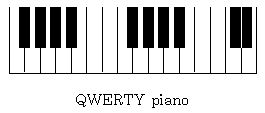Q: How the Typewriter Got Its Keys
The typewriter keyboard used almost universally in America (and with some variations throughout much of the world) was created by Christopher Latham Sholes, Carlos Glidden, and S. W. Soule around 1870. It's sometimes known as the Universal keyboard, but perhaps more commonly known as the QWERTY keyboard, after the first six letters in the upper left of the keyboard. (Ever tried to type "QWERTY"? If you're used to touch typing, it's a little strange to type a series of letters that lie next to each other...)

One of the design goals of the QWERTY keyboard was to separate frequently used pairs of letters, to prevent pairs of typebars from striking the platen at the same time and sticking together. The ordering of the keys may have been intended to physically separate pairs of typebars (since two typebars next to each other would jam more easily than two on opposite sides of the typewriter). Alternatively, it may have been because at the time, nobody had thought of touch typing, so the expectation was that people using the typewriter would use a two-finger hunt-and-peck approach; so separating common letter pairs spatially made it difficult to strike them in rapid succession.

There may have been other design goals as well. For instance, one story (which I gather is false) claims that all of the letters in the word "typewriter" were placed in the top row of letters in order to make it easier for salespeople to show off the machine's capabilities. (Such kludging-for-demos is of course common in today's software industry.) Another claim is that the letters roughly followed the arrangement of type in a printer's case, though I doubt that as well.

Whatever the goals, the resulting design placed the keys in an order that doesn't look remotely like the standard ordering of the letters in our alphabet. (An ordering, by the way, which I've usually taken for granted, but which is itself fairly arbitrary, at least from a modern point of view.) The cartoons reproduced here (created by Jim Moskowitz) show what might happen if we took a similar approach to re-ordering other common devices.
(As a side note, I had long believed that the alternate keyboard invented by Dr. August Dvorak was demonstrably superior to the QWERTY keyboard in a variety of ways; but a source I've recently encountered (though not entirely unbiased, as the authors were attempting to prove a point in economics) indicates that the few reliable controlled scientific studies that have been performed show little if any difference in speed of typing between experienced typists retrained on Dvorak keyboards and experienced typists given further training on QWERTY keyboards. The Dvorak keyboard may in fact be superior, particularly in reducing repetitive stress injuries, but has not yet been thoroughly proven to be superior.)

Jim points out that the clock example is particularly interesting, since it applies a discrete system to a continuum; even if you could use the QWERTY clock to usefully tell time, what would it mean for a hand to be between two numbers? My solution is to make the hour hand jump discretely from one number to the next, rather than slowly shifting position over the course of an hour.
On a related note, Mark-Jason Dominus has helpfully provided a QWERTY-sort word list, in which "alphabetical" order is determined by the order of the letters on a typewriter keyboard. After all, since it's unlikely that we're going to change the typewriter keyboard configuration, we might as well be consistent and re-order our dictionaries to fit... (If we were to decide on a different order, of course, the perl program Dominus wrote to sort a standard dictionary file into QWERTY order could easily be modified to sort in any new alphabetical order.) The list starts out with q, QED, queer, queen, and query, and ends with mnemonic.